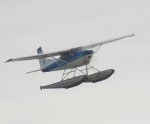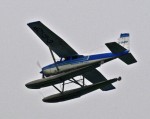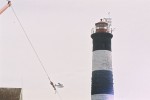 Shortly after 11 AM, Oct. 18/2009, a float plane over the reserve at very low altitude (well under 305 metres, (1000 ft.): reported by a kayak tour group.
|
|
For a Creel survey, the fisheries observer on board knows which are the restricted fishing areas and if he sees a vessel that appears to be engaged in sport fishing in a restricted area he tries to get the vessel’s license number or name to pass along to enforcement. It has a defined route that includes going by Race Rocks, usually at 500′. UPDATE: The flight on Oct.18 2009 was also a DFO Creel survey flight which went to 300’ to check out a vessel which appeared to be involved with sports fishing.
The Problem with Airplanes and Helicopters.Sea lions and harbour seals are especially wary of low flights by helicopters and airplanes usually leading to stampeding into the water.  A helicopter landing on the island at the wrong time of year can cause havoc among the seabird colony. This video shows the aftermath of a landing by a coastguard helicopter in August of 2003. At that time, the Glaucous winged Gull chicks are able to move around within the envelop of their nesting area but leaving that area means certain death by being pulled apart by other adults. This territorial behaviour has evolved as a mechanism to prevent overcrowding of nesting areas. The helicopter landing the tower resulted in an high mortality rate.
A helicopter landing on the island at the wrong time of year can cause havoc among the seabird colony. This video shows the aftermath of a landing by a coastguard helicopter in August of 2003. At that time, the Glaucous winged Gull chicks are able to move around within the envelop of their nesting area but leaving that area means certain death by being pulled apart by other adults. This territorial behaviour has evolved as a mechanism to prevent overcrowding of nesting areas. The helicopter landing the tower resulted in an high mortality rate.
From the DFO Consultation Secretariat: Updated draft of the Marine Mammal Regulation Amendments (5) (a) No one shall operate an aircraft for purposes of aerial marine mammal observation at an altitude of less than 1000 feet.; (b) For purposes of subsection (a) “aerial marine mammal observation” means any alteration of course of an aircraft in flight which is designed to bring the aircraft closer to the marine mammals.Comment: Aircraft (fixed wing & helicopter) are handled separately because of the demonstrated disturbance of aircraft when flying over marine mammals and the risk associated for the marine mammals and the aircraft when landing on the water. This proposed regulation is currently being reviewed by Transport Canada to ensure consistency with existing aviation regulations.NOTE: As of November 12, 2009, the regulations of Transport Canada still do not reflect the 1000 ft distance. We understand they are working on this to harmonize the policy between departments. Further note: In the regulations for flying in Alaska a greater elevation distance is required.
From: “How to View Marine Mammals from an Airplane or Helicopter
• Maintain a 1500-foot (457.2 metres) minimum altitude when viewing marine mammals from the air.
• Buzzing, hovering, landing, taking off, and taxiing near marine mammals on land or in the water is likely to harass the animals.”It would be useful if the US and Canada could have some agreed upon figure.
Return to the Environmental Impact and Disturbances Index:


